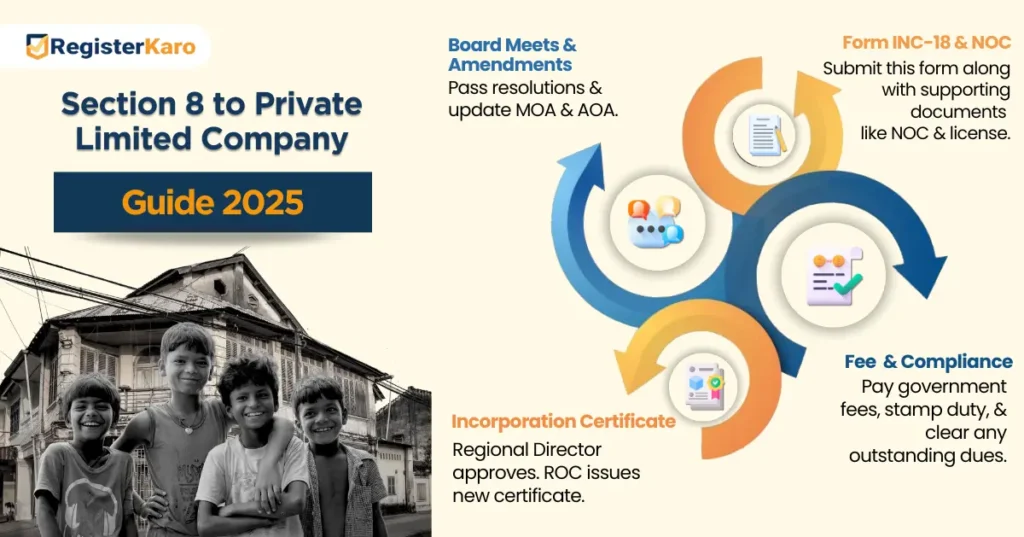
Converting a Section 8 Company to a Private Limited Company: A Complete Guide
From Being Charitable to Earning Profits
Ever thought about your non-profit organization stepping foot into the commercial world and earning profits? Let’s start your transformation journey and get your Section 8 company converted to a Private Limited structure. Navigating through this legal maze of company conversion can be a bit complicated. From special resolutions, document amendments to regulatory approvals, where do you even start?
Don’t worry, we at RegisterKaro have walked many companies through this process and will break it down into smaller steps. This strategic business decision requires careful planning and adherence to specific legal procedures under the Companies Act, 2013.
Whether you’re seeking growth opportunities, funding flexibility, or simply a broader business horizon, this comprehensive guide will be your trusted companion through every stage of the conversion process.
Understanding a Section 8 Company
A Section 8 company is a specialized business entity incorporated under Section 8 of the Companies Act, 2013 (previously Section 25 under the Companies Act, 1956). These companies are formed with the main objective of promoting different fields, thus making them easily available to the general public.
The main features of a Section 8 company are:
- Not profit-focused: These companies don’t focus on generating profits; rather, they use the same to complete and promote their objectives.
- Dividend distribution: A Section 8 company is not allowed to pay dividends to its members.
- Tax Benefits: A section 8 company is eligible for various tax exemptions as it works for the welfare of the community and not solely for generating profits.
- “Limited” Suffix Exemption: These companies can avoid using the “Limited” or “Private Limited” suffix with special permission.
- Central Government Oversight: Since these organizations work for the welfare of the general public, they require a special license from the Central Government.
A Section 8 company carries along with itself ideas of corporate social responsibility, charitable initiatives, and non-profit ventures. While we primarily will talk about converting a Section 8 company to a Private Limited structure but the reverse conversion process is also possible.
What Is a Private Limited Company?
A Private Limited company is a business entity incorporated under the Companies Act, 2013, designed primarily for earning profits and commercializing products. It represents one of the most popular business structures in India due to its balanced combination of operational flexibility and limited liability protection.
A Private Limited company offers distinctive benefits, including:
- Limited Liability: Shareholders’ liability is limited to the amount of their investment.
- Restrictive transfer of shares: Shares of a private limited company cannot be offered to the general public.
- Number of Members: There should be a minimum of 2 members, extending to a limit of 200.
- Separate Legal Entity: The company exists independently of its members, thus protecting them from being sued in the name of the company.
- Distribution of profits: The profits earned by a Private limited company can be shared with the shareholders in the form of dividends.
- Perpetual Succession: A private limited company continues to exist even if the members don’t.
Private Limited companies are ideal for businesses seeking capital investment, scalability, and professional management structures while maintaining relatively close control over ownership. Understanding these characteristics is essential when planning for the conversion of a Section 8 company to a private company.
Key Differences Between Section 8 and Private Limited Company
Going through the differences between these two types of companies is essential before you convert your business. While a basic understanding only lets you know the structures as charitable (Section 8) and profit-making (Private Limited), there is a lot more to know.
We can distinguish the two structures from each other in the following manner:
- When we talk about the primary objective, a Section 8 company is established for charitable or social purposes, whereas a Private Limited company focuses on commercial and profit-making decisions. Another major point of difference is the capability of a private limited company to share its profits with shareholders.
- If we talk about the membership, both structures require a minimum of 2 members, but a Section 8 company can have unlimited members, while a private limited company is restricted to 200 members. The transfer of shares, however, is restricted in both structures, with the Private Limited structure being a bit more flexible.
- Further, moving to tax benefits, Section 8 companies enjoy comparatively more tax benefits than a Private Limited Company. For example, under Section 12AA of the Income Tax Act, Private Limited companies are subject to standard corporate taxation, while the Section 8 companies aren’t. The name suffix also varies, with Section 8 companies allowed to use terms like “Foundation” or “Forum,” whereas Private Limited companies are restricted to the use of “Private Limited” in their name.
- Regulatory oversight is another area of difference, with Section 8 companies facing higher scrutiny from the Central Government, while Private Limited companies operate under standard ROC supervision. Neither type has a minimum capital requirement under current regulations. Upon dissolution, the assets of a Section 8 company must transfer to similar entities, while a Private Limited company’s assets are distributed among shareholders.
Why should you consider converting your company?
Still wondering if converting your company is worth all the effort? Let’s look at some reasons that are compelling enough to help you make this shift. Understanding these benefits will help you make a better decision that aligns with your future goals.
- Growth & Funding Opportunities
By converting your Section 8 company to a Private Limited structure, you may open doors to diverse funding sources that are typically unavailable to Section 8 entities. Private investors, venture capitalists, and angel investors generally prefer the Private Limited structure as it has:
- Clear ownership structure through the distribution of equity
- Greater potential for returns
- A well-established corporate governance framework
- Ability to issue different classes of shares
Having such advantages is why a private limited organization generally secures the necessary capital for expansion, diversification, and market penetration. Before conversion, one should realize that it would involve sacrificing these funding advantages for tax benefits and charitable status.
- Profit Distribution Flexibility
One of the most significant limitations of Section 8 companies is the prohibition on distributing profits to members. After converting your Section 8 company to a private company, your organization can:
- Distribute profits as dividends to shareholders
- Create performance-based incentive structures for key personnel
- Attract talent through employee stock option plans (ESOPs)
- Reinvest profits strategically without regulatory restrictions
- Create value for stakeholders through appreciation of share value
This flexibility allows dynamic business models and competitive compensation structures, which are key motivators for many organizations pursuing the conversion of a Section 8 company to a private limited company.
- Broader Business Scope
A Section 8 company is restricted to charitable or social objectives, that is stated in its memorandum. The Section 8 company conversion to a Private Limited entity enables:
- Expanding to commercial activities
- Diversification across multiple sectors
- Focusing on profit maximization
- Competitive positioning in open markets
Having a comparatively broader scope of work and sustainability can attract organizations looking to expand beyond their original charitable nature of work.
Legal & Regulatory Framework
For understanding the regulatory framework by which the conversion of a company is governed, one should know the laws and regulations. The Companies Act, 2013, provides the foundation for how these conversions must be conducted. Some of the major provisions of the act which majorly govern this process, are given below:
- Companies Act, 2013 Provisions
The conversion of a Section 8 company to a private company is governed primarily by:
- Section 8(4)(ii) of the Companies Act, 2013.
- Rules 21 and 22 of the Companies (Incorporation) Rules, 2014.
- Form INC-18 for application to the Regional Director.
The given provisions help in recognizing the legal framework, application process, and compliance requirements for the conversion of companies. The Act specifies that any alteration of the memorandum or articles that has the effect of converting a Section 8 company into any other kind of company shall be valid only if:
- It’s made with the prior approval of the Regional Director.
- The company files a copy of the approval with the Registrar within 30 days.
- All necessary compliance requirements are fulfilled.
- Role of Central Government & ROC
While converting a Section 8 company to a private limited company, one has to go through the office of the Regional Director(RD). This step is important because:
- The RD reviews and approves the conversion application.
- The Registrar of Companies (ROC) processes the post-approval documentation.
- The Central Government may impose conditions to safeguard public interest.
- The RD may conduct inspections or seek additional information.
- The final certificate of incorporation is issued by the ROC.
Maintaining transparent communication with these regulatory bodies throughout the Section 8 company conversion process is essential for a smooth transition.
Pre-Conversion Checklist
Preparing properly before initiating the conversion process can save you time, money, and potential complications. This checklist ensures you’ve covered all the necessary groundwork before submitting your application.
- Member Consent & Resolutions
Before one initiates the conversion of a Section 8 company to a Private Limited structure, they should take the following internal approvals:
- A special resolution for the conversion with at least a 3/4th majority of the members present and voting.
- A board resolution recommending the conversion.
- An explicit approval from the creditors is needed.
- Resolution addressing any ongoing charitable activity.
These resolutions serve as fundamental prerequisites for the regulatory approval process and demonstrate organizational consensus regarding the conversion of a company.
- No Objection Certificates (NOCs)
Before the actual conversion of a Section 8 company, it is mandatory to get NOCs from the following authorities:
- Income Tax Department.
- Any relevant regulatory bodies overseeing your charitable activities
- Primary donors or grant providers (if contractually required).
- Creditors with outstanding loans or financial arrangements.
- Government agencies that provided special permissions or licenses.
Obtaining a NOC from these authorities ensures that the relevant parties and creditors have been informed about the conversion and they have no objection to it. These assessments help in making sure that the conversion is within the knowledge of members/shareholders of the company.
Step-by-Step Conversion Process
STEP 1: Board Meeting & Special Resolution
The conversion of a Section 8 company to a private limited structure begins with the following steps:
- Schedule a Board meeting with a proper notice period.
- Pass a Board resolution recommending conversion to members.
- Call a General Meeting of members with proper notice.
- Pass a Special Resolution approving the conversion.
- Document all proceedings and voting outcomes.
The Special Resolution should clearly state the intention to convert from Section 8 to Private Limited status and address key aspects like name change, object clause modifications, and capital structure adjustments.
STEP 2: Amendment of MOA & AOA
As part of the conversion of Section 8 company, it is necessary to amend the primary documents accordingly for a private limited structure. These changes would involve
- Removing provisions related to non-profit objectives.
- Adding commercial objectives aligned with future business plans.
- Inserting clauses for a Private Limited Company.
- Add “Private Limited” suffix to the company name.
- Revise capital structure and shareholding provisions.
- Updating governance and management provisions.
These changes transform the basics of your company. The foundation on which the company was previously based is modified and made according to the needs of a new structure. This process, although it seems similar but would be highly different if it were the opposite case of converting a Private Limited company to a Section 8 Company.
STEP 3: Filing of Form INC-18
For the Section 8 company conversion, one has to submit the formal application using Form INC-18. This process would primarily include:
- Completing all fields in the prescribed Form INC-18.
- Attaching supporting documents, including a special resolution.
- Including the amended MOA and AOA.
- Providing a detailed statement of assets and liabilities.
- Finally, submitting a declaration of compliance by directors.
Form INC-18 is the primary application document for the Regional Director’s approval of the conversion of Section 8 company to pvt ltd.
STEP 4: Submission of NOC and Supporting Docs
Along with Form INC-18, an individual needs to submit these essential supporting documents for the conversion of a Section 8 company to a private company:
- NOC from the Income Tax Department.
- Audited financial statements for the past 3 years.
- Copy of the license issued under Section 8.
- Declaration by directors about compliance with conditions.
- NOCs from relevant regulatory bodies.
- Statement of assets and their proposed treatment post-conversion.
- List of pending litigations and statutory dues.
These documents provide regulatory authorities with a comprehensive understanding of your organization’s financial position and compliance status during the conversion process.
STEP 5: Payment of Fees & Stamp Duty
Next in line comes the completion of the financial aspects of the conversion. This would be concerned with the following steps:
- Paying the requisite government fees for conversion.
- Calculating and paying the applicable stamp duty for re-registration.
- Paying fees for the new authorized capital (if being increased).
- Clearing out any outstanding statutory dues.
- Maintaining a proof of record for all payments made.
Fee structures vary based on authorized capital and the state of registration. These financial requirements differ from those applicable to the conversion of a private company to Section 8, which may have different fee structures.
STEP 6: Issuance of New Certificate of Incorporation
Once the Regional Director approves the application for conversion of a Section 8 company to a private company:
- The approval order is communicated to the applicant.
- File the RD order with ROC within 30 days using Form INC-20.
- Submit updated documents as required by the ROC.
- ROC issues a fresh Certificate of Incorporation.
- The company officially becomes a Private Limited entity.
The new certificate represents the dissolution of the Section 8 company and officially establishes your Private Limited company status.

Essential documents required for the conversion
Documentation forms the backbone of your conversion application. Having all necessary paperwork prepared and organized is crucial for avoiding delays and ensuring regulatory compliance. For a smooth and hassle-free conversion of your Section 8 company to a private limited structure, you should ensure the preparation of these documents:
- Form INC-18: Application for conversion
- Special Resolution: Approving the conversion
- Amended MOA & AOA: Revised constitutional documents
- Board Resolution: Recommending the conversion
- Declaration of Solvency: Signed by directors
- List of Members: With their consent for conversion
- Asset and Liability Statement: Certified by CA
- NOC from Income Tax Department: For tax clearance
- Audited Financial Statements: For the last 3 years
- Copy of Section 8 License: Original license document
- Compliance Certificate: From the Company Secretary
- Details of Pending Litigations: If any
- List of Creditors: With their consent or NOCs
- Details of Immovable Properties: If any
- Transition Plan: For ongoing charitable activities
Organizing these documents in advance significantly accelerates the Section 8 company conversion process. The document requirements for conversion of private limited company to Section 8 company would be different and would follow a separate regulatory pathway.
Post-Conversion Compliance
Your responsibilities don’t end once you receive your new certificate of incorporation. As a Private Limited company, you’ll need to adhere to a different set of ongoing compliance requirements, some of which are:
- Annual Filings & Returns
After the successful conversion of a Section 8 company to a Private Limited Company, one should ensure regular compliance with the following documents:
- Annual Financial Statements: Submit audited statements annually
- Annual Return: File Form MGT-7 within 60 days of AGM
- Income Tax Returns: File as a regular business entity
- GST Returns: Monthly/quarterly as applicable
- Director KYC: Annual verification in Form DIR-3 KYC
- Annual General Meeting: Held within 6 months of the financial year-end
If the company fails to comply with any of these documents, it may face various legal penalties as well as the loss of goodwill.
- Changes to Board & Share Capital
The structure of a Private Limited company is completely different from that of a Section 8 company. Thus, after conversion, one should make sure of the following changes:
- Share Allocation: Shares should be allocated as per the new and updated structure of the company.
- Board Composition: The board of directors should be reconstituted according to the needs of the organization.
- Registered Office: Any pending and upcoming letterheads should be updated with the new registered office.
- Bank Accounts: The account details fo the company should be updated on all the legal documents of the company to avoid penalties and legal complexities.
- Business Licenses: The licenses should be updated according to the needs of a private limited structure.
These operational changes should be completed promptly after receiving the new Certificate of Incorporation following the conversion of a Section 8 company to a private company.
Common Pitfalls & How to Avoid Them
While converting a Section 8 company to a Private Limited company, an individual faces many challenges. Generally, these can be avoided by taking the help of field experts like RegisterKaro, but one should be aware of the following in general:
- Incomplete Documentation: The company should ensure that all supporting documents are properly prepared and certified.
- Objections from Stakeholders: One should communicate proactively with donors, beneficiaries, and partners to avoid any future differences.
- Non-compliance History: Resolve any pending compliance issues before applying
- Asset Transfer Issues: The assets that were acquired for charity should be clearly documented.
- Tax Implications: Since the tax structure of the company changes when converting it, one should seek the help of industry experts.
Working with experienced professionals can help you navigate these challenges during the conversion of Section 8 company to private company effectively.




